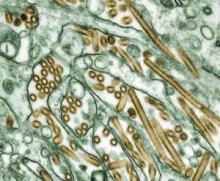Throw out a hint of some meaty research and say “Don’t Ask! Don’t Tell!” You might as well draw a map to the Christmas cache and tell the kids, “Don’t follow this trail!”
The U.S government seems to be engaging in the worst kind of this delusion by asking the journals Science and Nature to withhold the methodology sections of two important papers on H5N1 viral mutation.
The papers, one by University of Wisconsin-Madison veterinary virologist Yoshi Kawakoa and one by Dr. Ron Fouchier of Erasmus Medical Center in Rotterdam, Netherlands, detail their work on avian flu H5N1 mutation. Each describes genetic engineering that created a new strain almost 100% lethal to ferrets — generally considered best animals to model a human respiratory infection.
Presumably, Drs. Kawakoa and Fouchier conducted their experiments with the goal of helping to protect mankind against the virus’ inevitable change. But the National Science Advisory Board for Biosecurity sees a dark side. The agency’s official plea to both journals suggests that publishing “the methodological and other details … could enable replication of the experiments by those who would seek to do harm.”
Their concern is not unfounded: It goes without saying that an individual, or even a country, could use this with evil intent. A weaponized bird flu with a 90% or higher mortality rate would make the anthrax letters of 2001-2002 look like a kindergarten sandbox.
But is censoring going to keep this knowledge hidden?
Scientific discoveries almost always build upon prior knowledge in a long, nearly unbroken, chain of meticulous research. Researchers publish long strings of studies on the same topic, each one evolving just slightly from the last. Others with a passion for the same topic climb on board as well, so that eventually everyone benefits.
A clear representation of this? At least some of the research that so troubles our government has already been disseminated.
Last year, Dr. Kowakoa described his lab’s creation of an H5N1 mutation almost universally lethal to ferrets. The study describes his work with the two most virulent forms of H5N1, both isolated from humans and both with a human kill rate of up to 80%. Dr. Kawakoa and his colleagues manipulated the genes in both to create a novel virus that appears even more lethal, killing all of the intranasally inoculated ferrets.
The paper not only identifies the genes — hemagglutinin (HA) and nonstructural protein (NS) — but the method of reverse engineering and modifications’ chromosomal positions. Its purpose was not to create a super-pandemic among humans, but to identify the genes and loci that most contribute to H5N1’s uniquely dangerous potential.
His new paper, according to the National Institute of Health’s comment, shows “that the H5N1 virus has greater potential than previously believed to gain a dangerous capacity to be transmitted among mammals, including perhaps humans.”
Last September, Dr. Fouchier presented his now-to-be-edited work at the Fourth ESWI Influenza Conference. During an oral presentation, he described work that resulted in some potent H5N1 mutations. According to the conference daily, the researchers infected ferrets with the new H5N1, also formed by plasmid reverse engineering and also manipulating hemagglutinin. The infected ferrets died, but didn’t transmit the virus.
The team then let the virus do its own thing, just moving it repeatedly from a sick ferret’s nose to a healthy nose without tinkering – the way a virus in nature would mutate by adapting to each new host. Dr. Fouchier found a new H5N1 with new mutations: It became an airborne form after 10 transmissions, suggesting that avian flu can mutate within one species, rather than requiring a “mixing bowl” animal, like a pig.
“This virus is airborne and as efficiently transmitted as the seasonal virus,” the paper quoted Dr. Fouchier as saying. “This is very bad news, indeed.”
The meeting wasn’t secret. Journalists were there, and some even wrote about it. New Scientist ran a piece about the research, as did Scientific American.
If this much information is already out there, might it just be possible that a “rogue scientist” could come up with much, much more? And is the National Science Advisory Board for Biosecurity really suggesting that only two scientists in all the world have so advanced this virus?


